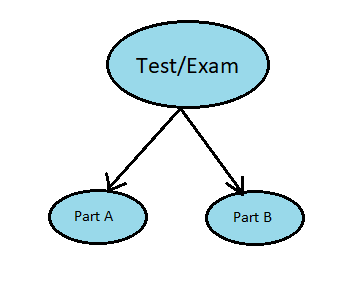Split half reliability is a way to measure the overall consistency of a test or an exam. It is a way of measuring the internal consistency of surveys and questionnaires in psychology and statistics.
Suppose a professor designs an exam to test a student’s knowledge of history. Suppose the questions are randomly divided into two halves and the student answers both parts.
If the test is well designed it is reasonable to expect that if the student performs well on one half then he also performs well on the other half of the test. If that does not happen we can conclude that the test has been designed poorly and is not a reliable way to measure a student’s knowledge of history.
The method explained in the above example where we split a test randomly into two parts to check for the internal consistency of the test is called split half reliability.
How to find Split Hlaf Reliability:
1. Divide the test into two parts; say part A and Part B. It is better to divide randomly than follow a fixed pattern because it eliminates bias on the part of the researcher. Alternatively, the researcher could divide the questions into odd-numbered ones and even-numbered ones to split the test into two parts.

2. Give the two parts separately as two different steps to some number of students.
3. If the performance of students in part A of the test is broadly similar to their performance in part B of the test, we conclude that the exam is internally consistent and reliable.
4. If the performance of students in part A of the test is very dissimilar to their performance in part B of the test, we conclude that the exam is not internally consistent.
5. The Split Half Reliability is found by calculating the correlation coefficient between the test scores of the two exams. If the correlation coefficient is positive then we conclude that the test is internally consistent. If the correlation coefficient is negative then we conclude that the test is not internally consistent.

Examples of Split Half Reliability:
Example 1: Suppose a test was split into two parts and given to 100 students. If the correlation coefficient between the marks obtained in the two parts is 0.977 then we conclude that the marks obtained in the two parts are similar and correlated 97.7% of the time.
This means that if a student performs well in part A he also performs well in part B. Thus we conclude that the test has high consistency and reliability.
Example 2: Suppose a test was split into two parts and given to 60 students. If the correlation coefficient between the marks obtained in the two parts is -0.177 then we conclude that the marks obtained in the two parts have a negative correlation.
This means that if a student performs well in part A then he does not perform well in part B. Thus we conclude that the test is not internally consistent. The test contains questions belonging to two different kinds of subjects and needs to be redesigned to be internally consistent.
Split Half Reliability vs Alternate Forms Reliability:
The concept of split half reliability must not be confused with that of alternate forms reliability. Alternate forms reliability involves administering the same test twice with minor changes at two different points of time whereas split half reliability involves dividing the test randomly into two parts and administering them only once.